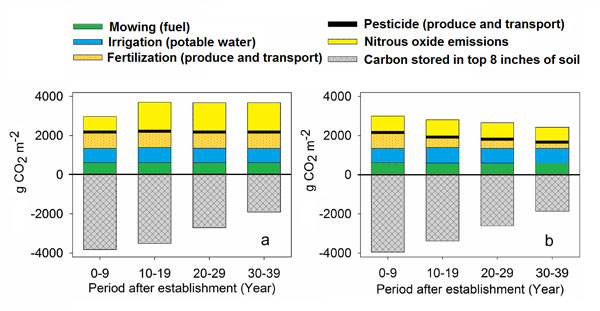(Above)Graduate students collecting gas samples from chambers installed on fairways for analysis of trace
amounts of nitrous oxide, methane and carbon dioxide gases.
Scientists at Colorado State University are collaborating with the U.S. Department of Agriculture’s
GRACEnet program to evaluate the carbon footprint of golf courses. GRACEnet is an acronym for the
Greenhouse Gas Reduction through Agricultural Carbon Enhancement Network that is under the direction of
the USDA’s Agricultural Research Service. To determine the impact of turfgrass management on the
greenhouse gas budget on golf courses, the project has made progress in several areas.
A survey of 17 golf course facilities is evaluating the fuel, electricity, and natural gas used
over the last three years. The preliminary results suggest that clubhouse and golf cart electricity use
was the greatest energy consumption associated with the Colorado golf course operations.
Katrina Gillette, a doctoral graduate student at Colorado State University, has measured changes in
greenhouse gases, such as nitrous oxide, methane and carbon dioxide, from golf course fairways, roughs,
native areas and putting greens. Eighty-five vented chambers installed on the various areas of a course
allow for collection of gas samples from inside the chambers. Weekly measurements taken throughout the
growing season and bimonthly in winter produced nearly 15,000 data points collected over a two-year
period. Nitrous oxide emissions were greatest from the fairway collection sites, and of the fertilizers
tested, POLYON had the lowest loss compared to BCMU and UMAXX. Nitrous oxide emissions from the putting
green and native sites were only about 10 percent of the emissions from fairways.
Yao Zhang, another Colorado State University graduate student, has applied the DAYCENT model to
turfgrass systems using data from previous field experiments for calibration. Simulated clipping yields,
evapotranspiration (ET), nitrate leaching, and soil temperature of Kentucky bluegrass turf compared well
with the measured values from golf courses (within 16 percent of the observed values). The DAYCENT model
tests best management practices for Kentucky bluegrass rough. For semiarid regions such as Colorado, the
model predicts a 50 percent reduction in nitrous oxide emissions when irrigation decreases from
replacing 100 percent of ET to 60 percent. The model simulation also suggested that gradually reducing
nitrogen fertilization as turf stands age from 0 to 50 years would reduce long-term nitrous oxide
emissions by 40 percent (Figure 1). The simulation indicates that the efficient use of resources such as
water and fertilizer can have a dramatic effect on the emission of greenhouse gases from golf course
turfgrass.

|
| DAYCENT model estimated greenhouse gas budget for high-quality Kentucky bluegrass roughs using (a) conventional management and (b) best management practices. Carbon dioxide, methane, and nitrous oxide greenhouse gases are converted to g CO2 m-2 for graphical presentation. The gray area represents the amount of carbon that the grass is able to store in the soil as organic matter. In this example, as the turfgrass ages, using lower amounts of a slow release nitrogen fertilizer significantly reduces the carbon footprint of the golf course rough. |
Source: Mike Kenna (mkenna@usga.org)
Additional Information: Carbon Footprint and Agronomy Practices
Contact the Green Section Staff

